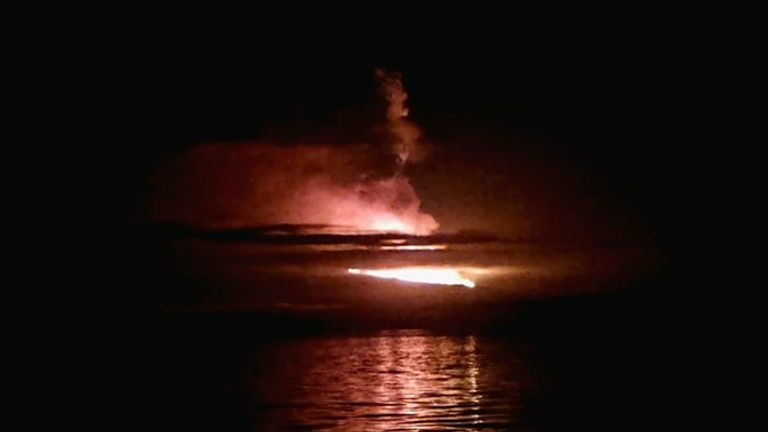Wolf Volcano in Galapagos Islands erupts spewing lava and clouds of ash over the Pacific Ocean
In May 2015, the volcano in the Galapagos Islands erupted for the first time in 33 years sending volcanic gases and ash roughly 50,000 ft (15km) into the sky, while lava flowed through a fissure, down eastern and southeastern slopes, and eventually reached the sea.
Friday 7 January 2022 15:48, UK
The tallest volcano in the Galapagos Islands has erupted, spewing lava and clouds of ash over the Pacific Ocean.
The Wolf Volcano, situated on Isabela Island, sent gas and ash around 3,793 metres (12,444ft) above sea level following the eruption, Ecuador's Geophysical Institute said.
Beginning just before midnight on Wednesday, the explosion caused lava to flow down the southern and southeastern flanks of the volcano, which is also known as Mount Whiton.
There was no immediate danger to populated areas located on the opposite side of the island, which is the largest in the Galapagos chain.
The institute added that at around 9:35pm local time a magnitude 2.4 earthquake was recorded, with its epicentre at the volcano.
At 11.15pm, a tremor signal was observed, which it stated was probably associated with the start of the eruption.
It also warned that interaction between fiery lava flows and seawater can cause explosions, so advised people to avoid arriving via sea.
The 1,701 metre (5,580ft) volcano is one of the numerous active volcanos in the archipelago, which are nearly 1,000km (600 miles) from mainland South America.
Images taken from afar and circulated by the government showed glowing lava piercing through the pre-dawn darkness.
The 2015 Wolf Volcano eruption
The volcano last erupted in 2015 - then the first time it had done so in 33 years.
According to NASA, it sent volcanic gases and ash roughly 50,000 ft (15km) into the sky and caused lava to flow through a fissure, down eastern and southeastern slopes into the sea.
In the early days of the eruption, the US government agency said conservation groups feared for the safety of a rare species of pink iguanas, which are only found on Isabela Island, and for the local population of giant tortoises and yellow iguanas.
However, neither species were endangered because the ash and lava flowed, similarly to the most recent eruption, east and southeast while the animals live mostly to the north and west of the summit.



